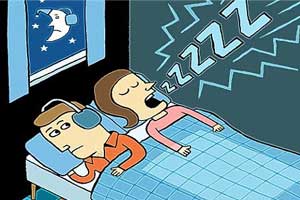- Home
- Editorial
- News
- Practice Guidelines
- Anesthesiology Guidelines
- Cancer Guidelines
- Cardiac Sciences Guidelines
- Critical Care Guidelines
- Dentistry Guidelines
- Dermatology Guidelines
- Diabetes and Endo Guidelines
- Diagnostics Guidelines
- ENT Guidelines
- Featured Practice Guidelines
- Gastroenterology Guidelines
- Geriatrics Guidelines
- Medicine Guidelines
- Nephrology Guidelines
- Neurosciences Guidelines
- Obs and Gynae Guidelines
- Ophthalmology Guidelines
- Orthopaedics Guidelines
- Paediatrics Guidelines
- Psychiatry Guidelines
- Pulmonology Guidelines
- Radiology Guidelines
- Surgery Guidelines
- Urology Guidelines
Obstructive sleep apnea more harmful for women's heart than men

Snoring and obstructive sleep apnea (OSA) among women leads to earlier impairment of cardiac function compared to men, according to a new study.
Findings of the study, presented at the annual meeting of the Radiological Society of North America (RSNA) suggests that OSA may be vastly underdiagnosed among snorers.
OSA is a common but dangerous sleep disorder that leads to an increased risk for left ventricular and, more rarely, right ventricular dysfunction in the heart. It is the most common type of sleep apnea that occurs due to intermittent relaxation of the throat muscles and blockage of the airway while a person sleeps. Common symptoms include loud snoring, gasping for air during sleep, morning headache, irritability and gasping for air during sleep. Complications include cardiovascular problems, daytime fatigue and sleepiness, and complications with medications and surgery.
Adrian Curta, radiology resident at Munich University Hospital in Munich, Germany, and colleagues investigated cardiac function in association with diagnosed OSA self-reported snoring from data available through UK Biobank, a national and international health resource.
For the study, the researchers analyzed data from 4,877 UK Biobank participants who had received a cardiac MRI. The patients were divided into three study groups: those with self-reported snoring (1,886 patients), those with OSA (118 patients), and those who are unaffected--without OSA or snoring (2,477 patients). 396 individuals did not meet the research criteria.
"Our analysis showed that in both genders of the OSA and snoring groups there was an increase in left ventricular mass, meaning that the walls of the heart's main pumping chamber are enlarged, making the heart work harder. We also found that men showed an increase in the ejection fraction of both ventricles," Dr. Curta said in a press release.
Ejection fraction is the percentage of the heart chamber's total volume that is pumped out with each heartbeat.
Key Findings:
- When the researchers compared the snoring group to the unaffected group, they found a more significant difference in the left ventricular mass in women than in men.
- The cardiac changes in the self-reported snorers point to earlier impairment and might be an indication of undiagnosed OSA.
- The cardiac parameters in women appear to be more easily affected by the disease and that women who snore or have OSA might be at greater risk for cardiac involvement.
- The prevalence of diagnosed OSA in the study group was extremely low.
- OSA may be grossly underdiagnosed, together with the alterations in cardiac function in the snoring group.
The findings suggest that the transition from snoring to OSA is an evolving process that is associated with left ventricular hypertrophy, an independent predictor for increased adverse events and in-hospital mortality in many procedures.
Dr. Curta stresses the importance of OSA screening for people who snore and cautions about the proper treatment of OSA.
"I would encourage people who snore to ask their partner to observe them and look for phases during sleep when they stop breathing for a short while and then gasp for air," he said. "If unsure, they can spend the night at a sleep lab where breathing is constantly monitored during sleep and even slight alterations can be recorded."
Treatment is dependent on the cause of an individual's OSA, Dr. Curta noted. Weight loss, for example, can often improve OSA in overweight individuals. Apart from that, there are surgical techniques and special machines that keep the upper airways open at nighttime by applying continuous positive airway pressure (CPAP).
Since this was a population study, the researchers hope to conduct further studies to gain more insight into the gender differences associated with snoring and OSA.

Disclaimer: This site is primarily intended for healthcare professionals. Any content/information on this website does not replace the advice of medical and/or health professionals and should not be construed as medical/diagnostic advice/endorsement or prescription. Use of this site is subject to our terms of use, privacy policy, advertisement policy. © 2020 Minerva Medical Treatment Pvt Ltd